IMEHA (International Model Equine Hobbyists Association) was an online photo showing site that existing until 2018. Included on the site were these guidebooks for judging and showing model horses in Performance classes. MEPSA has obtained permission to share the info contained in the guides.
IMEHA offers the following Presentation Classes
A Halter or Headstall Is Required
No Handlers Allowed
Western Halter Section:
Presentation Western Stock Breed
Presentation Western Light Breed
Presentation Western Pony Breed
Presentation Western TB – WB – Sporthorse Breed
Presentation Western Other Breed
English Bridle Section:
Presentation English Bridle Stock Breed
Presentation English Bridle Light Breed
Presentation English Bridle Pony Breed
Presentation English Bridle TB – WB – Sporthorse
Presentation English Bridle Other Breed
Arabian Headstall Section:
Presentation Arabian Native Headstall
Presentation Arabian Cultural Headstall and Collar
Presentation Arabian Dubai Halter
Presentation Arabian Light Breed Style Arena Headstall
Headstall Suited to Breed Section:
Presentation Draft Horse
Presentation Light and Pony Breeds In Hand – No Arab
Presentation Gaited Horse
Presentation Baroque Breeds
Presentation Donkey – Mule – Zebra
Suitability for Dressage
Foal or Yearling Section:
Presentation Western Foal or Yearling
Presentation Other Discipline Foal or Yearling
Fitting the Western Halter
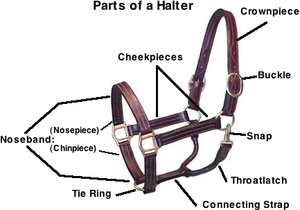
The nose strap crosses and bisects the bridge of the horse’s nose.
Two chin straps connect the nose strap to the lead-strap ring that rests beneath the horse’s lower jaw.
Two cheekpieces run up the sides of the horse’s head.
The crown crosses the horse’s poll and is buckled into place once the halter’s put on the horse.
The throatlatch runs beneath the horse’s throatlatch.
The bottom connector strap runs from the throatlatch to the lead-snap ring.
A well-constructed silver show halter should have five points of adjustment, with buckles on each side of the crown, at the end of each chin strap, and on the bottom-connector strap. The five-piece construction allows you to fine-tune the halter’s fit to the shape of an individual horse’s head. In addition, strong, bendable wire inside the throatlatch piece allows you to shape that strap along the curve of his jowl.
Good-fit Tip:
Each adjustable strap should be buckled snugly against your horse’s head. Otherwise, the halter flops as the horse moves, and shifts and twists when you apply pressure to the lead shank.
Aa show halter also has three straps that can’t be adjusted. These are the nose strap, the two cheekpieces and the throatlatch. If these pieces are too short or too long for a particular horse’s head, the faulty proportions distort the final picture. You won’t be able to make the halter fit well, no matter how much you tighten or loosen the five adjustment points.
A good show halter’s straps should vary in width from size to size; the smaller the halter size, the narrower the straps. So a weanling-size straps should be more narrow than the adult horse halter.
Good-fit tip:
For a show halter to flatter your horse’s head, its cheekpieces, after all buckles have been tightened, must rest parallel to the front plane of his face. If they angle back toward the throatlatch, his head will appear distorted.
How do you know the halter fits correctly:
If any of these following five steps cannot be accomplished with the halter you’re using, it doesn’t fit the horse.
- Tighten both sides of the halter’s crown piece evenly until the nose strap rests snugly against the protruding bone marking the lower end of the facial crest. If the crown is the proper length, this adjustment will allow the nose strap to bisect the horse’s face between eye and nostril in a flattering, proportionate way.
- Check the location of the side ring that connects crown-strap buckle, cheekpiece and throatlatch. If the cheekpiece and throatlatch are the proper lengths, the side ring will rest just below the protruding bone between eye and ear to mark the juncture of jowl and throatlatch.
- The cheekpiece as it rests on the jowl must lie parallel to the line of the facial crest, forming a pleasing frame for the upper portion of the horse’s face.
- The throatlatch piece should follow the contour of the horse’s jowl. Besides enhancing the jowl, this creates visual balance with the upper and lower portions of the face.
- Complete the halter adjustment by snugging the chin straps, and by tightening or loosening the bottom connector strap to rest up slightly into the groove of the jowl against the horse’s head. This will make some the width of disappear giving a more slim line look to the bottom of the horse’s head. The worst thing you can do is have the connector strap hanging loose away from the under the horse’s head
- The attachment and use of chain under the chin, over the nose or doubled and clipped back to lead is allowed. No chain lead is allowed to be clipped directly to the “O” ring under the chin on the halter.
The chain should be adjusted so that the excess protrudes about two to six inches from the halter. The horse is lead from the left side with the hand on the lead strap about 8 to 12″ from the halter. Smaller exhibitors may need to use a longer hold on the lead strap. Hold the excessive lead strap in the left hand, either in a rounded or flatten (collapsed)figure 8 or in a round coil. All turns of the horse shall be to the right with the exhibitor walking to the right around the horse. If a judge is standing at the rear quarter of the horse the showman must be on the same side of horse as judge. If judge is standing at the front quarters of the horse the showman is on the opposite side of horse as judge. The showman never stands directly in front of horse but slightly off to one side, even when asking horse to back and reset. The exhibitor is only required to show the horse to the judge from the distance of one horse on either side of where the judge is standing but should keep in mind the audience is also viewing the class and should be attentive to the horse for the time they are in the arena. When lining up either head to tail or in the line up, the horse must be stood squarely on all four feet. The exhibitor will be required to travel his horse individually, leading the horse into whatever the pattern or request judge or ring steward asks for. Exhibitors must keep proper position in line and allow reasonable space of at least 5 feet between horses.
Fitting the English Bridle
Parts of Hunt Seat or Snaffle Bit:
Crownpiece: The crownpiece, headstall (US) or headpiece (UK) goes over the horse’s head just behind the animal’s ears, at the poll. It is the main strap that holds the remaining parts of the bridle in place.
Cheekpieces: On most bridles, two cheekpieces attach to either side of the crownpiece and run down the side of the horse’s face, along the cheekbone and attach to the bit rings. On some designs, the crownpiece is a longer strap that includes the right cheek and crownpiece as a single unit and only a left side cheekpiece is added. Browband: The crownpiece runs through the browband. The browband runs from just under one ear of the horse, across the forehead, to just under the other ear. It prevents the bridle from sliding behind the poll onto the upper neck, and holds multiple headstalls together when a cavesson or second bit is added, and holds the throatlatch in place on designs where it is a separate strap. In certain sports, such as dressage and Saddle seat, decorative browbands are sometimes fashionable.
Noseband: the noseband encircles the nose of the horse. It is often used to keep the animal’s mouth closed, or to attach other pieces or equipment, such as martingales. Frentera, a strap running from the browband to the noseband, primarily seen on bridles of certain South American designs.

1. Ordinary snaffle with single-jointed mouthpiece.
2. Ordinary snaffle with double-jointed mouthpiece.
3. Racing snaffle (D-ring).
4. Snaffle. A) w/cheeks, w/ or w/o keepers. B) without cheeks (Egg-butt).
5. Snaffle with upper or lower cheeks.
6. Unjointed snaffle (Mullen-mouth).
7. Snaffle with cheeks. (Hanging or drop cheek; Baucher). This may be a D-ring or other ordinary snaffle as pictured in Nos. 1-
8. Dr. Bristol.
9. Fulmer.
10. French snaffle.
11. Snaffle with rotating mouthpiece
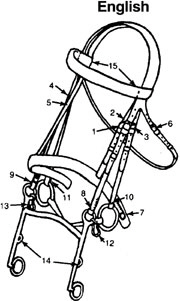
Parts of Double Bridle:
- Left cavesson cheekpiece
- Left curb headstall cheekpiece
- Left bridoon cheekpiece
- Right curb headstall cheekpiece
- Right bridoon cheekpiece
- Throatlatch
- Cavesson
- Left curb bit attachment
- Right curb bit attachment
- Left bridoon attachment
- Right bridoon attachment
- Left curb chain hook
- Right curb chain hook
- Lip strap hooks
- Browband
Double bridle, where the horse carries two bits (a curb and small snaffle, often called a “bit and bradoon”), a second, smaller headstall, known as a ‘bradoon hanger’ or ‘slip head’ is used to attach the bradoon. A second set of reins is attached to the bradoon, and hence the rider carries four reins.
The bridle, depending on style, may also contain some of the following elements: Bit guards: Bit guards are optional fittings used on some bits.
Curb strap or curb chain, used primarily on bridles with a curb bit, a small strap or chain, usually flat, that runs from one side of the bit to the other, and puts pressure on the chin groove when curb reins are tightened. Shank hobble: A strap, bar or chain that connects the shanks of a curb bit at the bottom of the bit. Serves to stabilize the bit, prevent a lasso or other object from being caught on the shanks.
Ornaments such as phalerae and sallongs. A phalera is an ornament in the shape of a boss, disk, or crescent, most often used in pairs on a horse’s harness. It often had 3 attachment points on the back, two for attachment to the leather and one for attachment of a tassel or “sallong”. It is also used on the sides of the browband of the bridle. A sallongs is seen on Hungarian double and snaffle bridles. These can be front and side sallongs (intricately braided leather which are traditional decorative fly-repellents.
 Sallongs | 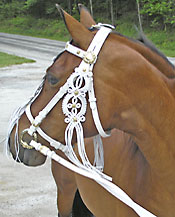 Sallongs with Phalera on Browband | 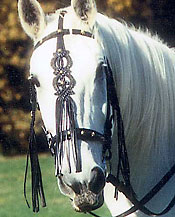 Sallongs |
Fitting the Double Bridle
Fit the bridle in the same way as a snaffle bridle would be fitted, ensuring that the bridoon is lying over the curb.
Leave the straps of the cheekpieces out of the buckles, to make adjusting the height of the bit easier to do quickly.
Make sure the browband is not so tight that it pulls the bridle onto the bulbs of the horses ears.
Both bits should fit easily in the mouth with a finger’s width clearance on either side.
The bridoon should be ¼ inch wider than normal to allow room at the corners of the mouth for the curb. The horse’s lips and cheeks will be pinched and the lower jaw will be unable to relax during work if the bits are too tight. Equally is they are too wide they will pull through the mouth and most of the relevant action will be lost.
Make sure the bits chosen are not too thick in the mouthpiece for the size of the horse’s mouth and the size of the tongue. The horse will hold its mouth open and show signs of discomfort if the bits are too thick.
The bridoon bit, on its separate headpiece, should fit exactly like an ordinary snaffle, slightly wrinkling the corners of the horse’s lips. The sliphead should buckle on the offside.
Once in the horse’s mouth, the curb should lie slightly below the bridoon when viewed from the side. The curb mouthpiece is then effective on the bars and tongue and avoids the lips. Make sure it is not sitting so low that it touches the tushes (in male horses).
Buckle the throat lash and noseband as on an ordinary snaffle, ensuring the noseband is not too low, as this can interfere with the bridoon.
The curb chain should already be fastened onto the offside hook: twist it clockwise until it lies flat, and fit it into the groove above the fleshy part of the horse’s chin. Hook the appropriate link onto the nearside hook so that the hook maintains the pressure of the clockwise turning motion, and if there are more than two links left over hook the last loose one over the top.
To check the curb: take up the curb rein and move the bit to about 45°. The curb chain should sit neatly in the chin groove. Too loose and it will encourage the horse to open its mouth and resist, if too tight it will act like a vice and the horse will be very uncomfortable.
Put the lip strap through the fly link and buckle on the nearside.
Western Presentation for Stock Breeds
Entries into this class are any stock breed, such as QH, Appaloosa, Paint, etc. that for whatever reason is showing in a western halter. Be sure that your comment line correctly give a valid reason as to why the entry is wearing and performing in a Western halter. Current show style is to show both the adult horses and foal with a pulled and banded mane. It is recommended to use short trimmed mane style models and keep the long mane models for breed and color classes. Presentation Classes: The halter or headstall is judged as 50% of the class premium and the horse’s conformation, breed type and gender plus photo quality make up the other 50%.
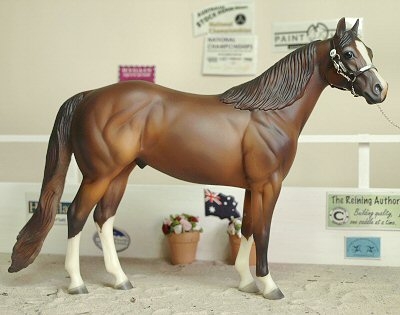
AK Touchdown to Success
Info: Chestnut QH Stallion
Mold: OF Stone ISH ‘Plums Flashy’
Comments: Waiting to be lead forward into the ring.
Western Presentation for Light Breeds
Entries into this class are any light breed, such as Morgan, Arabian, Gaited, etc. that for whatever reason is showing in a western halter. All rules are the same as for Western Stock Breeds. Be sure that your comment line correctly give a valid reason as to why the entry is wearing and performing in a Western halter.
Presentation Classes: The halter or headstall is judged as 50% of the class premium and the horse’s conformation, breed type and gender plus photo quality make up the other 50%.
Western Presentation for Pony Breeds
Entries into this class are any pony breed, such as POA, Connemara, Quarter Pony, etc. that for whatever reason is showing in a western halter. All rules are the same as for Western Stock Breeds. Be sure that your comment line correctly give a valid reason as to why the entry is wearing and performing in a Western halter.
Presentation Classes: The halter or headstall is judged as 50% of the class premium and the horse’s conformation, breed type and gender plus photo quality make up the other 50%.
Western Presentation for TB, WB or Sporthorse Breeds
Entries into this class are any TB, WB or Sporthorse breed, that for whatever reason is showing in a western halter. All rules are the same as for Western Stock Breeds. Be sure that your comment line correctly give a valid reason as to why the entry is wearing and performing in a Western halter.
Presentation Classes: The halter or headstall is judged as 50% of the class premium and the horse’s conformation, breed type and gender plus photo quality make up the other 50%.
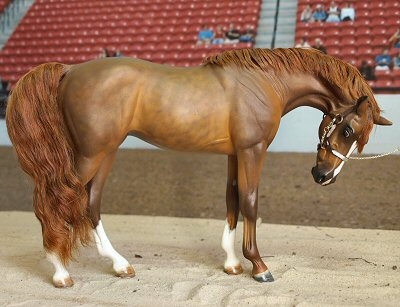
Dainhill Supremacy
Info: Chestnut TB Mare
Mold: AR Sedona painted by Faye Cohen
Shown by: Ann Baldock
Comments: Western lead class at an indoor arena under lights, been shown in western halter class for TB Mares
Western Presentation for Other Breeds
Entries into this class are any Other breed such that not a stock breed, Light breed or TB, WB or Sporthorse breed, that for whatever reason is showing in a western halter. All rules are the same as for Western Stock Breeds. Be sure that your comment line correctly give a valid reason as to why the entry is wearing and performing in a Western halter. Presentation Classes: The halter or headstall is judged as 50% of the class premium and the horse’s conformation, breed type and gender plus photo quality make up the other 50%.

WNS Challenger
Info: Dark Brown TWH Stallion
Mold: Breyer Clock Saddlebred CCM by Sudekum
Shown by Sue Sudekum
Comments: Showmanship: Set up for judge’s inspection
Presentation English Bridle Stock Breed
Stock Horses are judged in an In Hand Class for conformation, temperament, movement, etc.
Bridles:
English style bridle is optional mandatory.
Hunt Seat Bridle:
Hunt Seat Bridle may use an eggbutt, D-ring, O-ring or full cheek snaffle bit. Twisted, twisted wire, roller or knife edge bits and any variety or inhumane mouthpiece are not allowed.
Full Bridle, Pelham, Kimberwicke or Weymouth:
Full Bridle, Pelham, Kimberwicke or Weymouth may also be used.
The commonly used white lined dressage bridle with dropped nose band is permitted as well as a newmarket chain. Decorative bridles and silver halters are prohibited.
Leading The Horse:
The Lead has several options of which all are legal:
Snaffle Bridles:
Snaffle Bridles are led by the reins, of which are not placed over the head but instead are hanging down from the bit. The handler’s right hand will hold the reins with length long enough for handler to stand at the horse’s throatlatch. The left hand will hold the bight of the reins which may be coiled, folded or the bight resting neatly in hand.
Full Bridles:
Full Bridles option to show off either snaffle or curb; or handler may carry both reins in hand.
Pelhams, Weymouth or Kimberwicke:
Pelhams, Weymouth or Kimberwicke with four reins, option to show off either set, non-leading rein to be draped over withers in both situations Or, handler may carry both reins in hand.
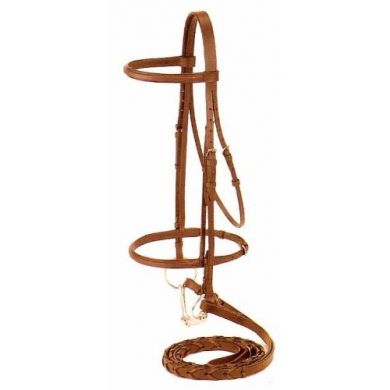
Presentation English Bridle Light Breed
Light Breed Horses are judged in an In Hand Class for conformation, temperament, movement, etc.
Presentation Classes: The halter or headstall is judged as 50% of the class premium and the horse’s conformation, breed type and gender plus photo quality make up the other 50%.
Bridles:
English style bridle is optional mandatory.
Hunt Seat Bridle:
Hunt Seat Bridle may use an eggbutt, D-ring, O-ring or full cheek snaffle bit. Twisted, twisted wire, roller or knife edge bits and any variety or inhumane mouthpiece are not allowed.
Full Bridle, Pelham, Kimberwicke or Weymouth:
Full Bridle, Pelham, Kimberwicke or Weymouth may also be used.
The commonly used white lined dressage bridle with dropped nose band is permitted as well as a newmarket chain. Decorative bridles and silver halters are prohibited.
Leading The Horse:
The Lead has several options of which all are legal:
Snaffle Bridles:
Snaffle Bridles are led by the reins, of which are not placed over the head but instead are hanging down from the bit. The handler’s right hand will hold the reins with length long enough for handler to stand at the horse’s throatlatch. The left hand will hold the bight of the reins which may be coiled, folded or the bight resting neatly in hand.
Full Bridles:
Full Bridles option to show off either snaffle or curb; or handler may carry both reins in hand.
Pelhams, Weymouth or Kimberwicke:
Pelhams, Weymouth or Kimberwicke with four reins, option to show off either set, non-leading rein to be draped over withers in both situations Or, handler may carry both reins in hand.

Presentation English Bridle Pony Breed
Pony Breeds are judged in an Hand In Class for conformation, temperament, movement, etc.
Presentation Classes: The halter or headstall is judged as 50% of the class premium and the horse’s conformation, breed type and gender plus photo quality make up the other 50%.
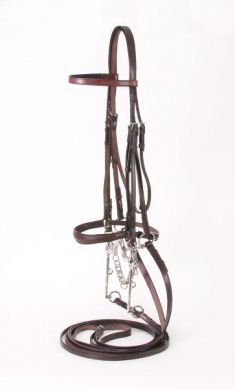
Bridles:
English style bridle is optional mandatory.
Hunt Seat Bridle:
Hunt Seat Bridle may use an eggbutt, D-ring, O-ring or full cheek snaffle bit. Twisted, twisted wire, roller or knife edge bits and any variety or inhumane mouthpiece are not allowed.
Full Bridle, Pelham, Kimberwicke or Weymouth:
Full Bridle, Pelham, Kimberwicke or Weymouth may also be used.
The commonly used white lined dressage bridle with dropped nose band is permitted as well as a newmarket chain. Decorative bridles and silver halters are prohibited.
Leading The Horse:
The Lead has several options of which all are legal:
Snaffle Bridles:
Snaffle Bridles are led by the reins, of which are not placed over the head but instead are hanging down from the bit. The handler’s right hand will hold the reins with length long enough for handler to stand at the horse’s throatlatch. The left hand will hold the bight of the reins which may be coiled, folded or the bight resting neatly in hand.
Full Bridles:
Full Bridles option to show off either snaffle or curb; or handler may carry both reins in hand.
Pelhams, Weymouth or Kimberwicke:
Pelhams, Weymouth or Kimberwicke with four reins, option to show off either set, non-leading rein to be draped over withers in both situations Or, handler may carry both reins in hand.

Bob E Socks
Info: Bay Tobiano Welsh B / Dutch Warmblood Hunter Pony Gelding
Mold: CM Traditional Pony Of The Americas
Shown by: Xaviara Augenblick
Comments: In line for judging.
Presentation English Bridle TB, WB, or Sporthorse Breed
Presentation Classes: The halter or headstall is judged as 50% of the class premium and the horse’s conformation, breed type and gender plus photo quality make up the other 50%.
TB, WB or Sporthorse Horses are judged in an In Hand Class for conformation, temperament, movement, etc. They have manes braided in a style appropriate for their discipline, and usually have their tails either braided or pulled. Other than cleanliness, braiding, and basic show trimming of legs, muzzle, ears and a short bridle path, grooming products are kept to a minimum and excessive oils and polishes are frowned upon.
Bridles:
English style bridle is optional mandatory.
Hunt Seat Bridle:
Hunt Seat Bridle may use an eggbutt, D-ring, O-ring or full cheek snaffle bit. Twisted, twisted wire, roller or knife edge bits and any variety or inhumane mouthpiece are not allowed.
Full Bridle, Pelham, Kimberwicke or Weymouth:
Full Bridle, Pelham, Kimberwicke or Weymouth may also be used.
The commonly used white lined dressage bridle with dropped nose band is permitted as well as a newmarket chain. Decorative bridles and silver halters are prohibited.
Leading The Horse:
The Lead has several options of which all are legal:
Snaffle Bridles:
Snaffle Bridles are led by the reins, of which are not placed over the head but instead are hanging down from the bit. The handler’s right hand will hold the reins with length long enough for handler to stand at the horse’s throatlatch. The left hand will hold the bight of the reins which may be coiled, folded or the bight resting neatly in hand.
Full Bridles:
Full Bridles option to show off either snaffle or curb; or handler may carry both reins in hand.
Pelhams, Weymouth or Kimberwicke:
Pelhams, Weymouth or Kimberwicke with four reins, option to show off either set, non-leading rein to be draped over withers in both situations Or, handler may carry both reins in hand.

Setting Up the TB, WB or Sporthorse
The horse is stood up for judging in an “open” stance, in that the front and hind legs are not lined up squarely, but rather the two front legs and two hind legs are placed with one leg slightly in front of the other, so that all four legs can be seen simultaneously from the side. The head and neck are allowed to be held at a natural position, thought the handler may subtly raise or lower the head a bit to flatter the individual horse.
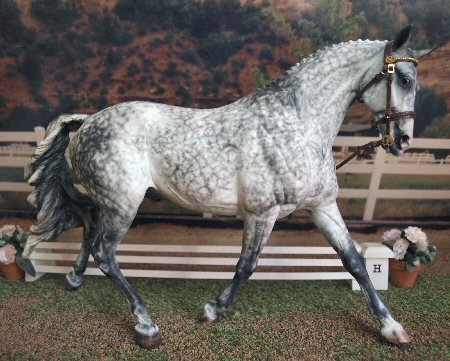
Sauve n Sophisticated
Info: Dappled Grey Holsteiner WB Stallion
Mold: AR Deputed Duke
Shown by: Ann Baldock
Comments: Being shown in hand in a stallion bridle at a stud demonstration day.
Presentation English Bridle Other Breed
Breeds other than stock, light or TB, WB, or Sportbreed Horses are judged in an Hand In Class for conformation, temperament, movement, etc. Presentation Classes: The halter or headstall is judged as 50% of the class premium and the horse’s conformation, breed type and gender plus photo quality make up the other 50%.
Bridles:
English style bridle is optional mandatory.
Hunt Seat Bridle:
Hunt Seat Bridle may use an eggbutt, D-ring, O-ring or full cheek snaffle bit. Twisted, twisted wire, roller or knife edge bits and any variety or inhumane mouthpiece are not allowed.
Full Bridle, Pelham, Kimberwicke or Weymouth:
Full Bridle, Pelham, Kimberwicke or Weymouth may also be used.
The commonly used white lined dressage bridle with dropped nose band is permitted as well as a newmarket chain. Decorative bridles and silver halters are prohibited.
Leading The Horse:
The Lead has several options of which all are legal:
Snaffle Bridles:
Snaffle Bridles are led by the reins, of which are not placed over the head but instead are hanging down from the bit. The handler’s right hand will hold the reins with length long enough for handler to stand at the horse’s throatlatch. The left hand will hold the bight of the reins which may be coiled, folded or the bight resting neatly in hand.
Full Bridles:
Full Bridles option to show off either snaffle or curb; or handler may carry both reins in hand.
Pelhams, Weymouth or Kimberwicke:
Pelhams, Weymouth or Kimberwicke with four reins, option to show off either set, non-leading rein to be draped over withers in both situations Or, handler may carry both reins in hand.
Arabian Presentation Native Headstall
The presentation of Arabian horses in their natural costume-like Arabian headstall in their natural setting. Headstall may be of halter or bridle style. Bridle may have bit, hackamore or other suitable style. Bridle may have halter-type braided headstall with one rein that turns from the left only or ornate bit with two reins. May have tassels, chains or other embellishment on it. May be of Bedoiun or any region of Middle East or of Hollywood Style. Presentation Classes: The halter or headstall is judged as 50% of the class premium and the horse’s conformation, breed type and gender plus photo quality make up the other 50%.
Arabian Presentation Cultural Headstall and Collar
The presentation of Arabian horses in their cultural styled Arabian headstall and matching chest collar in a natural setting, advertisements setting, or a ceremonial or specialized show setting. May be a bridle with have bit, hackamore or other suitable style. Bridle may have halter-type braided headstall with one rein that turns from the left only or ornate bit with two reins. May have tassels, chains or other embellishment on it.

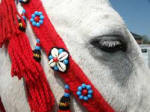
May be of Bedoiun or any region of Middle East or of Hollywood Style. Presentation Classes: The halter or headstall and the collar is judged as 50% of the class premium and the horse’s conformation, breed type and gender plus photo quality make up the other 50%.
Arabian Presentation Dubai Halter
The presentation of the Dubai style halter in a natural setting, advertisements setting, or a ceremonial or specialized show setting. The Dubai Arabian halter typically has braided silk cord or woven pattern cheek pieces with tassles or other embellishment on the cheekpieces. A nosepiece of small link chain with embellished hanging chain deocrations such as mini daggers. A lead that matches the woven style and coloration of the cheekpieces. The chain lead is not allowed to come to a straight “v” but as a sliding keeper on it. This is for safety reasons so the horse can not rear up and get a foot through the lead.


There is no throat latch on this style headstall. Scenes using this headstall are typically at shows held in Dubai (not is USA where there is a mandatory throatlatch required), in advertisements, stallion service auctions, and photo opportunities. Presentation Classes: The Dubai halter is judged as 50% of the class premium and the horse’s conformation, breed type and gender plus photo quality make up the other 50%.
Presentation Arabian Light Breed Style Arena Headstall
The entry for this class must be in an arena setting. Presentation Classes: The halter or headstall is judged as 50% of the class premium and the horse’s conformation, breed type and gender plus photo quality make up the other 50%. Arabian Presentation requires an Arabian Light Breed style halter is a very fine, thin show halter with minimal decoration, designed to show off the refined head that is a characteristic of the breed. The halter has a mandatory throatlatch. The chain goes under the chin and is clipped back to the lead. The length of the chain is normally about 12″ so there is some double backed length that hangs down but not enough as to make it dangerous and allow a horse to rear and get a front foot through the part of the chain that hangs down. For safety purposes many people use an adjustable sliding keeper on the chain to regulate how much opening is left between the two sides of the chain that form the “v” back to the leadshank. (See the example below – the black sliding keeper on the lead.) Throatlatches may be loose or tight but do not as much as in Native Arabian Headstalls. If you can get more than 2 fingers through the throatlatch chain it is too loose.
The conformation stance for the breed is to have the front feet square and the back feet parted so that one leg is set perpendicular to the ground, and the other slightly behind it, in order to tighten and flatten the relatively horizontal croup and show off the high-set tail that are breed characteristics. The head is carried high and the neck stretched out. Class procedure is similar to the action breeds, with somewhat greater emphasis on the stand-up for individual presentation.
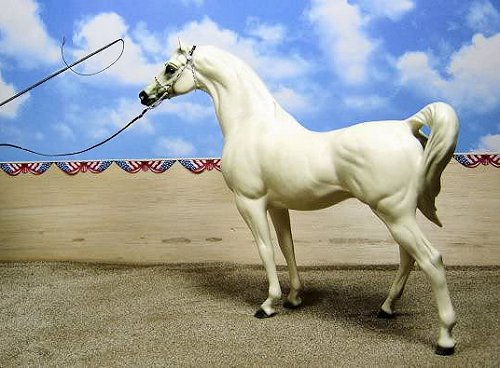
Azraff Badieh Emir, shown as a gray Arabian Stallion, is a Hagen-Renaker B 11 Nataf. Owned and shown by Dee Whitley with the comment: Arabian Presentation. In the true tradition the handler uses the whip “only” to keep Azraff’s attention as the judge come over to get a good look at this beautiful Stallion.

Presentation Draft Horse
Stallions under eight months of age or mares and geldings of any age are eligible for show. The horse should be presented in a thrifty, well-cared-for condition, neither thin nor excessively fat. The animal should be clean. Tails may be natural or docked, braided or left long, but fit to the proportions of the horse. Manes may be rolled and decorated. Feet may be shod or unshod, but should be properly trimmed and clean. Black or natural hoof paint is acceptable. Halters and leads may be of leather, nylon or rope and should be clean and fitted to the horse. Show sticks and bridles will be allowed.
Class Procedure:
Horses will enter the ring at the trot and line up side by side at the direction of the ring steward. Horses will be pulled from the line, walked to the judge or ring steward, walked to the opposite end of the arena (to the ring steward or judge), turned, and trotted back to the starting point. The turn at the far end of the arena should not be over the horse’s hocks, but a slightly widened arc that results in the horse facing the opposite direction in line with the judge and ring steward when the turn is completed. After showing horse on the move, stop the horse and set the horse up. Return to the line after the judge excuses horse. Horses should be shown with all four feet positioned correctly under the body while in line. The judge will closely inspect and may handle each horse. A trailer (person to assist with moving the horse) with or without a whip is permitted. The trailer should cross to the opposite side prior to the turn and should never get between the judge and the horse when the horse is in line, but should stand behind the exhibitor some distance away and may assist in keeping the horse alert. Deviations from this description may be necessary, and will be announced prior to the beginning of the class.
Presentation Classes: The halter or headstall is judged as 50% of the class premium and the horse’s conformation, breed type and gender plus photo quality make up the other 50%.
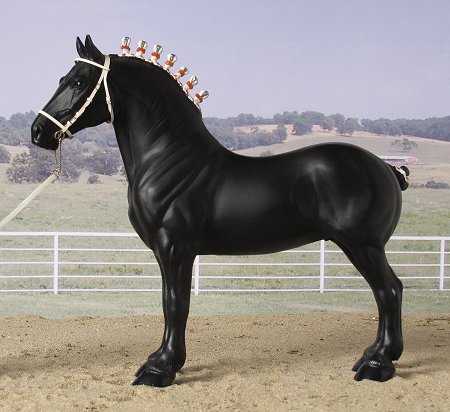
Presentation Draft Horse
Chevrolet McAtmos, shown as a Black Percheron Gelding, is a PS Standing Drafter Goliath. Owned and shown by Mona McGraw with the comment: Standing for inspection by the judge in a Draft Presentation Class.
Stallions wear what is termed a “stud bridle” which is adjustable white leather with a snaffle bit and a chain under the chin. Mares, geldings, and foals are normally shown in draft breeds show halter with no bit. The chain runs under the bars of the jaw instead. However (there are always exceptions and different breeds are listed below.) A rope halter is allowable in some breeds for their mares, geldings and foals. The rope halter is one solid length of rope that makes up the halter and revolves into a lead. Some breeds display their stallions in stud tack (a surcingle usually made of leather and bridle with side reins with or without a crupper. The belt itself goes around the barrel where the girth of a saddle would fit and can be black, brown or white. This is not seen in Belgians or Percherons any longer.
Handlers wear dark pants and white shirts (no flashy clothes)
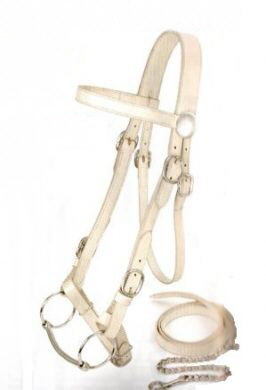

Photo Credit:
Draft Horse Headstall
Chevrolet McAtmos, shown as a Black Percheron Gelding, is a PS Standing Drafter Goliath. Owned and shown by Mona McGraw.
Mares are normally left natural, but in pulling contests the manes are sometimes roached along with the forelock. Almost all American drafters have docked tails. Hoof black is used in most breeds except Clydesdales, even on horses with white feet. Long tails from horses in UK should not be penalized, but the tail should be plaited in some manner, not just hanging loose. Draft mares shown in hand only have their tails braided (no mane decorations) Male horses have their manes rolled and their tails braided for halter showing. The forelock is combed and left natural or can can braided into a single strand with a ribbon tied in a small bow at the end. The roll at the start of the mane following the bridle path and continues down the neck until just aobve the withers. The bunting can be long enough to almost reach the horse’s elbow. Rosettes made of crete paper, ribbon, fake silk or plastic flowers (usually tulips or rosebuds) with floral wire “stalks” are placed in the mane roll. Seven rosettes is the norm, maybe 5 to 9 in certain cases, but always an odd number for symmetrical look. In England and especially on the Suffolk breed is the continental braid. The braid runs along the bottom of the mane and is the same as “french braiding” human hair. There is usually a light colored bunting that matches closely or complements the horse’s mane color plaited into the braid. All tails are braided for showring in harness and halter. The tail of a correctly braided horse (docked version) looks like a woman’s bun hairdo. The tail is then decorated with ribbons that match the mane decorations. England outlawed docking of horse’s tails , so instead you will see the tail braided from the top down in a hunter fashion or the tail bone shaved except for a fringe a the dock which is braided in the traidtional tight bun and decorated with ribbons. Occasionally you will see a draft breed with long flowing tails with bows a the dock for onamentation.
Rolled manes for harness for rolled shorter than halter or in hand showing. Referred to as “breaking off before the harness bed” Manes are decorated with 5 rosettes for harness regardless of sex. It is common to see mares, geldings and stallions in 6 and 8 horses hitches, hence the need for uniformity.
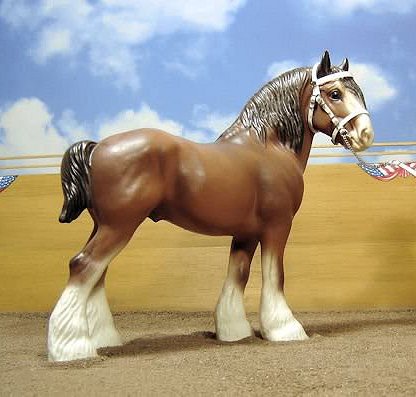
Presentation Draft Horse
Mighty Mosses, shown as a Bay Clydesdale Young Stallion, is a Hagen-Renaker B50 Clydesdale. Owned and shown by Dee Whitley with the comment: Draft Presentation. Mosses is set up now & awaiting for the judge’s final inspection.
British Drafters are shown with a satin ribbon around the neck just before the shoulders with the horse’s show number on it. British horses cannot have docked tails. Germany no longer allows tail docking and the Belgian horse society of Europe has also ruled against the practice. European and Canadian Draft Association and Dr. Sharon E. Cregier of the Equine Behaviour Forum would like to remind us of the cruelty associated with docking and its complete unnecessity.
The tack is usually much more ornate than the USA as well.
Percherons are normally shown in white leather. Stud tack is not used, black or tan is not used. Facial hair and lower legs are trimmed. hoof black is used. A show stick is permissible. White rope halters are allowed on foals, mares and geldings.
Shires are shown in the “normal” fashion listed above with the exception that black, brown or fashionably trimmed tack is used and white is not seen in the show ring.
Suffolks are shown in white tack and mane is rolled in plaited French braid.
American Belgian shown in white leather and stallions do not use the surcingle. A tuft of hair is left at the ankle and down the pastern to the back of the hoof and rest of leg is trimmed. Show sticks allowed as are whippers (a second person who runs behind the horse to make it move out.)
Brabant show in surcingle and white or black leather is used.
Clydesdales are shown in a white rope, natural rope or leather halter or stallion bridle (white or tan) Stallions may show in surcingle. Leadlines should match halter. Mares, geldings and foals show in rope halters or leather draft halter. Mares and gelding may use a bridle as well. Muzzle and eye hairs are trimmed, long hair under jaw and on belly not trimmed. A bridle path is not required. Any horse over 2 years old is shod. Stallions/geldings have rolled manes and tails, mares and foals with tail braids only. Mare’s mane is usually plaited for the Royal show in Toronto but this is the only show i which they are so decorated. No hoof blacking allowed. No show sticks or whips or whippers allowed.
Presentation Light and Pony Breeds
Light Breeds such as Morab and the National Show Horse, as well as part-Arabian pinto horses, do not have any braiding or banding that interferes with a naturally long, free-flowing mane and tail. (Unless specifically shown as sport horses, then hunter-style braiding and presentation is permissible). The conformation stance is to have the front feet square and the back feet parted so that one leg is set perpendicular to the ground, and the other slightly behind it, in order to tighten and flatten the relatively horizontal croup and show off the high-set tail that are breed characteristics. The head is carried high and the neck stretched out. Class procedure is similar to the action breeds, with somewhat greater emphasis on the stand-up for individual presentation. Presentation Classes: The halter or headstall is judged as 50% of the class premium and the horse’s conformation, breed type and gender plus photo quality make up the other 50%.
They are presented in a very fine, thin show halter with minimal decoration, designed to show off the refined head that is a characteristic of the breed. Handlers usually wear similar attire to those showing action breeds, though some instead choose to wear Western-style attire. They are as extensively groomed as the action breeds, though manes and tails are never clipped or artificially enhanced, other than the clipping of a bridle path and ponies are generally shown in light breed halter with mandatory throat latch.

A Touch Too Much
Info: Chestnut Morgan Mare
Mold: AR Godiva by Tom Bainbridge
Comments: Shown in her halter class for Light bred mares. Lead out before the judge for her workout
Presentation Gaited Horse
Horses are generally shown with the curb bit portion of a saddle seat style double bridle, or in a very thin, refined show halter, usually of black or patent leather with a colorful noseband (and, sometimes, browband). Usually the forelock and one or two sections of the mane has a brightly colored ribbon braided into it, and false tails are permitted. Clipping styles vary by breed and by discipline within some breeds, but proper clipping is an art form and far more extensive than for the sport horse or stock breeds. Action breeds are groomed extensively with silicone sprays on the coat, oils to add shine to the face, and hoof polish common.
Presentation Classes: The halter or headstall is judged as 50% of the class premium and the horse’s conformation, breed type and gender plus photo quality make up the other 50%.
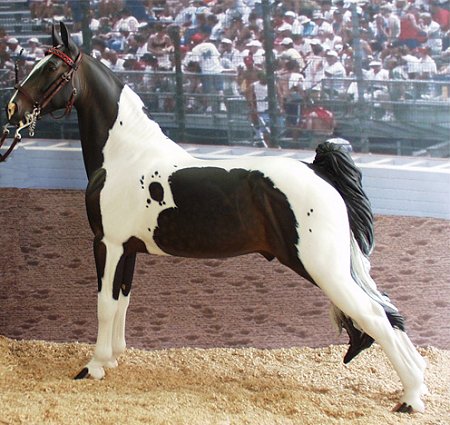
On It Boss
Dark bay tobiano TWH gelding
Mold: AR Independence
Owned and shown by Ilaria Dotti
Comment: TWH in-hand class. Horse is parked out for the judge’s inspection.
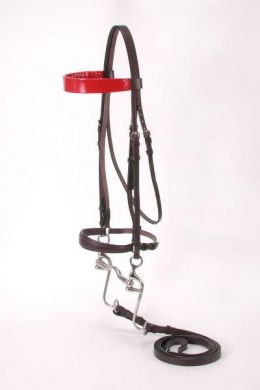
ASB are normally shown with a bridle or leather show halter on a long lead. Halter chain may be placed any way, but usually seen over the nose. Snaffle bits used in younger horses, curbs used for horses 2 years and up with a single rein or full double bridle with both reins pulled down and lead jointly. Handlers should be dressed conservatively. Two handlers permitted at the trot (header and tailer.)
MFT wear a show halter or bridle (regardless of gender or age) foals wear a show halter. Bridles should be of the browband type. Cavessons are optional, but it is customary to use one. Browbands and nosebands typically match the color of the ribbons, currently white is the popular color used. When a bridle is used, grazing, snaffle, curb, and halfbreed bits are permitted, but Walking Horse S-curbs are the most common. An occasional Western curb is seen. Curb chains are permitted. Handlers typically wear suits, often with contrasting yokes and cowboy hats. Women typically wear slacks, dress shirt and a coordinating vest or short jacket. Whips are permitted.
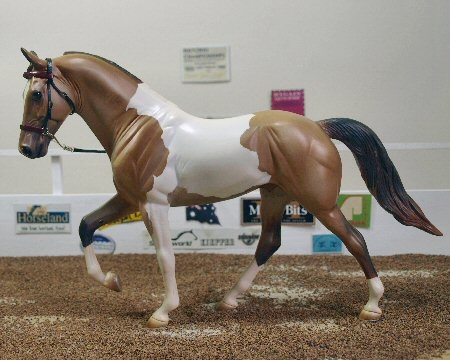
AK Darbys Tribute
Info: Bay tobiano pinto TWH stallion
Mold: Stone TWH ‘Nicodemus’
Shown by: Ann Baldock
Comments: Being led back to the class line up to await the judges decision.
TWH wear a Walking Horse Bridle with a single rein. Colored browbands are considered appropriate, but rhinestones are forbidden. Weanlings and yearlings are shown in a light breed show halter. Handlers wear habits or suits. Foal handlers wear a collared shirt (long or short sleeves) and tie. Hats are recommended during evening performance, caps and hats are optional during the day. Handlers may carry a whip.
NSH may or may not exhibit gaits. But usually a NSH with or without Saddlebred gaits is shown in a light breed show halter with chain under the jaw.
Presentation Baroque Breeds
The Baroque horse breeds such as the Friesian, Andalusian and Lipizzan, usually are shown in styles similar to what is done with each breed in Europe, in that clipped bridle paths and excessive greases or oils are avoided. Manes and tails are generally left loose and flowing.
Presentation Classes: The halter or headstall is judged as 50% of the class premium and the horse’s conformation, breed type and gender plus photo quality make up the other 50%.
Tack
They are usually presented either in a hunter or harness-style show bridle or in a halter similar to those used by Arabians, but sized heavier, depending on breed and part of the country in which the breed is shown. The horse is stood up for judging in an “open” stance, in that the front and hind legs are not lined up squarely, but rather the two front legs and two hind legs are placed with one leg slightly in front of the other, so that all four legs can be seen simultaneously from the side. It is often referred to as the pyramid stance and is also used by Thoroughbred, Warmbloods, Sporthorses and most breeds in the UK. Baroque horses are judged strongly on movement and athleticism.
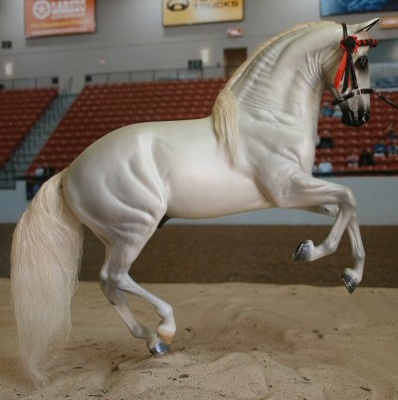
Conversano Australis II
Info: White Lipizzaner Stallion
Mold: AR Tenorio by Faye Cohen
Shown By: Ann Baldock
Comments: Being shown at a Stallion Parade in Spanish halter, wanting to perform the Levade, a movement performed by Lipizzan stallions at The Spanish Riding School of Vienna. For refer:http://www.lipizzaner.com/home.asp Then go to Airs above the Ground.
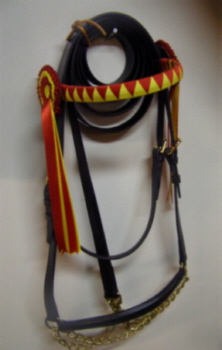
Longear Presentation
Mules and donkey typically show in plain leather stock halters but silver is also allowed. Leads are usually leather with a chain lead that is placed under the chin, over the nose or doubled and clipped back to lead. Jacks must show in a stallion halter with chain over nose.
Presentation Classes: The halter or headstall is judged as 50% of the class premium and the longear’s conformation, breed type and gender plus photo quality make up the other 50%.
Suitability for Dressage
Horses are judged (not the handler) individually on a triangle course. The horses approach the judging area and set up for inspection in an “open” position with all four legs visible by the judge standing on either side of the horse. At the judge’s request the horse will then walk a small triangle ABCA. The horse will continue on at a trot following the larger ADEA. At the completion of the judging the handler will lead the horse away from the judging area. As one horse leaves the next one will enter the judging area promptly. When all horses in class have completed the triangle course they may be lined up for judge’s to place, or “ringing” (walking in a large group circle around the judge) may used. Scoring system is 60% movement, 30% conformation, 10% temperament.

Tack
English style bridle is optional on yearlings and younger horses and mandatory on older horses. Bridle must have eggbutt, D-ring, O-ring or full cheek snaffle bit. Twisted, twisted wire, roller or knife edge bits and any variety or inhumane mouthpiece are not allowed. The commonly used white lined dressage bridle with dropped nose band is permitted as well as a newmarket chain. Decorative bridles and silver halters are prohibited. Young horses show in plain leather or nylon halter. They may also show with a chiffey bit attached to the halter. The use of chain under the chin, over the nose or doubled and clipped back to lead is allowed. No chain lead is allowed to be clipped directly to the “O” ring under the chin on the halter.
Presentation Western Foal or Yearling
This class is open the western halter style of showing a suckling, weanling or yearling. Stock horses breeds show in western halter. The use of chain under the chin, over the nose or doubled and clipped back to lead is allowed. No chain lead is allowed to be clipped directly to the “O” ring under the chin on the halter.
Presentation Classes: The halter or headstall is judged as 50% of the class premium and the horse’s conformation, breed type and gender plus photo quality make up the other 50%.

AK Simply Irresistible
Info: Bay pinto Australian Stock horse Filly
Mold: FCM Weanling ‘Miss Mazey’
Shown by Ann Baldock
Comments: Looking around to see where the judge went to.
Showmanship Other Discipline Foal or Yearling
This class is open to all styles of showing a suckling, weanling or yearling. Light breeds show in a light breed halter. TB, WB, Sporthorse or other young horse breed that requires control show in plain leather or nylon halter. They may also show with a chiffey bit attached to the halter at 6 months through yearling year. The use of chain under the chin, over the nose or doubled and clipped back to lead is allowed. No chain lead is allowed to be clipped directly to the “O” ring under the chin on the halter.
Presentation Classes: The halter or headstall is judged as 50% of the class premium and the horse’s conformation, breed type and gender plus photo quality make up the other 50%.

Hucks Wildchild
Info: Chestnut tobiano NSH Filly
Mold: FCM Arab Yearling
Shown by: Ann Baldock
Comments: Trotting across the top of ring in lead class for NSH fillies under 2 yrs.
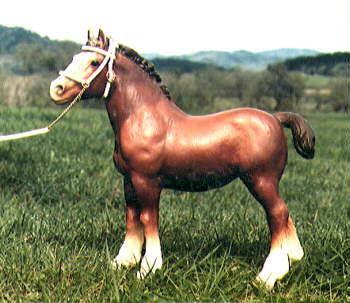
Highland Lass
Mold: Clydesdale Filly
Shown by: Traci Durrel Khalife.
Comment: A Clydesdale foal shown in show halter of white leather.
